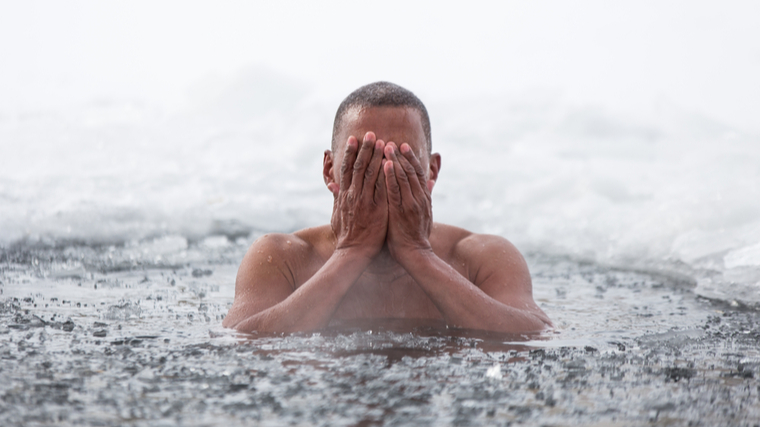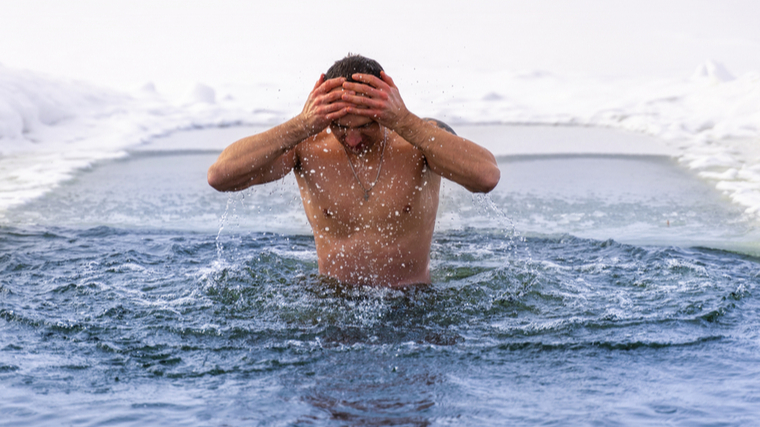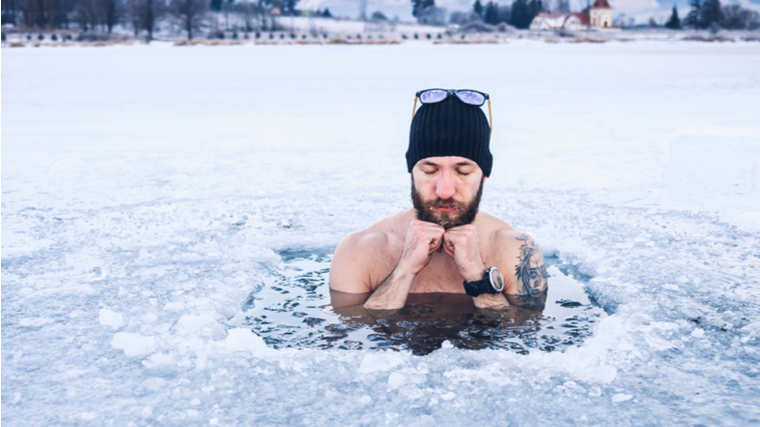Especially if you’re from a chillier region, you might scoff at someone saying that 59 degrees is cold. But when the water you’re immersing yourself in is below 60 degrees, it’s definitely on the shiver-inducing side. And that’s what a cold plunge is — slipping into water that’s under 60 degrees. But why?

Plenty of athletes turn to cold plunges after intense workouts to hasten their recovery, boost energy levels, and even improve mental health. But how does one even do a cold plunge? And when? And do cold plunges, you know, actually work? Here’s everything you need to know about cold plunges for athletes.
What is a Cold Plunge?
A cold plunge, otherwise known as cold water immersion, is literally when you immerse yourself in extremely cold water. Some athletes do this with the intention of improving their recovery after a hard workout. Others have the goal of being less sore after going hard in the gym. Still other folks find it both relaxing and a challenge.
Spending between five and 15 minutes in 10 to 15-degree Celsius water may be the most effective way to practice cold water immersion or cold plunges. (1) The longer you stay immersed, the more relatively warm you might want the water to be. A cold plunge’s effectiveness also may depend on how long you wait until your next exercise bout.
How Do Cold Plunges Work?
People often tout cold plunges as being beneficial for recovery. Colder temperatures can help reduce swelling and tissue breakdown. Think of that ice pack you put on after you sprained your ankle in high school. Cold water immersion has been found to reduce an athlete’s level of neopterin, a nucleotide that indicates inflammation in your body. (2)

During training, your muscle cells sustain a lot of damage. Repairing from that damage is how your muscles eventually grow. When you immerse yourself in cold water, the temperature constricts your blood vessels. In part because of this constriction, cold plunges have been shown to help flush waste products like lactic acid out of your muscle tissues. (3) Cold plunges can even reduce levels of cortisol — a hormone often associated with stress — in athletes’ saliva. (2)
However, cold plunges aren’t necessarily more effective than regular active recovery at reducing inflammation and muscular stress responses. (4) That doesn’t mean that cold plunges are necessarily ineffective. It just means that it’s not the only way to spark recovery after training.
Do Cold Plunges Work?
As to whether cold plunges work, it really depends. What are you trying to accomplish? Do you want the sweet satisfaction of freezing after a hot workout, or are you looking to reduce soreness? When are you plunging, and when are you working out again afterward? Even your body type has an effect on whether cold plunges will work for you.
Research has shown that there is no one-size-fits-all with cold plunges. They might be more effective for some people than others because of factors like water temperature and duration. Factors as diverse as people’s unique physiques, the type of exercise they do, and water-immersion protocols also impact cold plunge’s effectiveness. (5) Even in a study of elite Olympic weightlifters, researchers found that individual responses to cold water immersion varies from person-to-person. (6)

Giving athletes who had just completed a high-intensity interval training session a placebo to boost recovery has worked just as well at improving their recovery over 48 hours as cold water immersion. (7) Cold water immersion has been shown to improve athletes’ perception of recovery up to 72 hours after an intense effort. (8) So, cold plunges may indeed be effective at enhancing your perception of recovery — if you like them, they may serve as a good placebo.
Potential Benefits of a Cold Plunge
For goals like reducing muscle soreness and helping you compete more often in a short period of time — think a CrossFit competition over multiple days — cold plunges may be just what you’re looking for. There is some evidence that cold water immersion can reduce muscle soreness after intense workouts. (9) Cold water immersion might be better than hot water immersion and passive resting at improving recovery from high-intensity cycling. (10) Even though cold water immersion might make you less sore the next day, it may not necessarily help boost your performance. (11)
However, that reduced soreness might be especially important when athletes have to compete multiple times within a span of hours or consecutive days. Cold water immersion has been shown to improve sprint performance up to 24 hours after an intense bout when tested on athletes engaged in a tournament simulation. (12) Similarly, cold water immersion may be able to help athletes work more in subsequent training sessions — which can be very helpful if you’re trying to boost your work capacity and long-term gains. (13)
Cold plunges may be particularly useful for combat sport athletes. In studies centered around simulated MMA competitions and other intensive MMA conditioning training, researchers found that cold water immersion improved recovery after 10-meter sprints that accompanied competitors’ training. Athletes also reported better perceived wellness 24 hours later, as well as reporting less perceived fatigue and soreness. (14)(2)
Potential Drawbacks of a Cold Plunge
Cold plunges don’t work for everyone in every circumstance. Especially if you’re going to work out again soon after plunging, your body might not adjust well. Even though it might increase people’s perception of soreness, ice water immersion may not actually minimize muscle soreness on a physiological level. (15) It’s possible that immersing limbs you just trained into cold water might actually decrease the muscular strength and endurance benefits of resistance training. (16)

Peak power production, average heart rate, and post-exercise blood lactate have all been shown to decrease when trying to perform cycling sprints after cold water immersion. (17)(18) So, immersing too often might hinder your training. Cold water immersion has also been shown to limit long-term gains in muscle mass and strength and block the activation of important proteins in muscle cells. (19)
How to Do a Cold Plunge
Immersing yourself from anywhere between five to 15 minutes in 10 to 15°C water can be effective for practicing cold plunges. (1) If you’re planning to stay immersed in cold water longer, the water should usually be on the less-cold end of the spectrum. So if you’ve never done a cold plunge before, you’ll likely have to build up a tolerance.
Take time to figure out what feels right for your body in terms of when you start doing cold plunges. Diving right into full-body immersion might be less helpful than immersing some limbs first and letting your body get used to it from there.
As with any part of your strength training, you want to gradually progress your practice. Start with shorter periods of time with relatively less cold water. Increase the amount of time little-by-little. Then, go back to a shorter period of time with slightly colder water. Gradually increase your amount of time again.
In terms of integrating cold plunges into your program, consecutive days of short cold plunges may be effective. (20) It’s been shown that when athletes perform intense cycling training, then stand for five minutes in 10°C water each day for three days, they were able to maintain their cycling performance each day.
Getting Colder
Interested in improving your recovery and limiting muscle soreness after intense workouts? You may just want to explore the wide world of cold plunges, or cold water immersion. They seem to impact different athletes differently, depending on a wide range of factors. Proceed with the same gradual approach with which you learn a new lift or take a new supplement.
If you enjoy cold plunges, research says they may help you. If you don’t like them, there’s probably not a need to suffer through it. Some good old-fashioned active recovery may be just what you need.
References
- Versey NG, Halson SL, Dawson BT. Water immersion recovery for athletes: effect on exercise performance and practical recommendations. Sports Med. 2013 Nov;43(11):1101-30.
- Lindsay A, Carr S, Cross S, Petersen C, Lewis JG, Gieseg SP. The physiological response to cold-water immersion following a mixed martial arts training session. Appl Physiol Nutr Metab. 2017 May;42(5):529-536.
- Morton RH. Contrast water immersion hastens plasma lactate decrease after intense anaerobic exercise. J Sci Med Sport. 2007 Dec;10(6):467-70.
- Peake Jonathan M., Markworth James F., Cumming Kristoffer Toldnes, Aas Sigve N., Roberts Llion A., Raastad Truls, Cameron-Smith David, Figueiredo Vandre C. The Effects of Cold Water Immersion and Active Recovery on Molecular Factors That Regulate Growth and Remodeling of Skeletal Muscle After Resistance Exercise. Frontiers in Physiology. 2020 (11).
- Stephens JM, Halson S, Miller J, Slater GJ, Askew CD. Cold-Water Immersion for Athletic Recovery: One Size Does Not Fit All. Int J Sports Physiol Perform. 2017 Jan;12(1):2-9.
- Schimpchen J, Wagner M, Ferrauti A, Kellmann M, Pfeiffer M, Meyer T. Can Cold Water Immersion Enhance Recovery in Elite Olympic Weightlifters? An Individualized Perspective. J Strength Cond Res. 2017 Jun;31(6):1569-1576.
- Broatch JR, Petersen A, Bishop DJ. Postexercise cold water immersion benefits are not greater than the placebo effect. Med Sci Sports Exerc. 2014 Nov;46(11):2139-47.
- Higgins TR, Greene DA, Baker MK. Effects of Cold Water Immersion and Contrast Water Therapy for Recovery From Team Sport: A Systematic Review and Meta-analysis. J Strength Cond Res. 2017 May;31(5):1443-1460.
- Bleakley, Chris et al. “Cold-water immersion (cryotherapy) for preventing and treating muscle soreness after exercise.” The Cochrane database of systematic reviews vol. 2012,2 CD008262.
- Vaile J, Halson S, Gill N, Dawson B. Effect of hydrotherapy on recovery from fatigue. Int J Sports Med. 2008 Jul;29(7):539-44.
- Yeung SS, Ting KH, Hon M, et al. Effects of Cold Water Immersion on Muscle Oxygenation During Repeated Bouts of Fatiguing Exercise: A Randomized Controlled Study. Medicine (Baltimore). 2016;95(1):e2455.
- Leeder JDC, Godfrey M, Gibbon D, Gaze D, Davison GW, Van Someren KA, Howatson G. Cold water immersion improves recovery of sprint speed following a simulated tournament. Eur J Sport Sci. 2019 Oct;19(9):1166-1174.
- Roberts LA, Nosaka K, Coombes JS, Peake JM. Cold water immersion enhances recovery of submaximal muscle function after resistance exercise. Am J Physiol Regul Integr Comp Physiol. 2014 Oct 15;307(8):R998-R1008.
- Tabben M, Ihsan M, Ghoul N, Coquart J, Chaouachi A, Chaabene H, Tourny C, Chamari K. Cold Water Immersion Enhanced Athletes’ Wellness and 10-m Short Sprint Performance 24-h After a Simulated Mixed Martial Arts Combat. Front Physiol. 2018 Nov 1;9:1542.
- Sellwood, Kylie Louise et al. “Ice-water immersion and delayed-onset muscle soreness: a randomised controlled trial.” British journal of sports medicine vol. 41,6 (2007): 392-7.
- Yamane M, Ohnishi N, Matsumoto T. Does Regular Post-exercise Cold Application Attenuate Trained Muscle Adaptation? Int J Sports Med. 2015 Jul;36(8):647-53.
- Schniepp J, Campbell TS, Powell KL, Pincivero DM. The effects of cold-water immersion on power output and heart rate in elite cyclists. J Strength Cond Res. 2002 Nov;16(4):561-6.
- Crowe MJ, O’Connor D, Rudd D. Cold water recovery reduces anaerobic performance. Int J Sports Med. 2007 Dec;28(12):994-8.
- Roberts LA, Raastad T, Markworth JF, et al. Post-exercise cold water immersion attenuates acute anabolic signalling and long-term adaptations in muscle to strength training. J Physiol. 2015;593(18):4285-4301.
- McDonald A, Goode RC, Livingstone SD, Duffin J. Body cooling in human males by cold-water immersion after vigorous exercise. Undersea Biomed Res. 1984 Mar;11(1):81-90.
- Stanley J, Peake JM, Buchheit M. Consecutive days of cold water immersion: effects on cycling performance and heart rate variability. Eur J Appl Physiol. 2013 Feb;113(2):371-84.
Featured Image: Ratushniak / Shutterstock